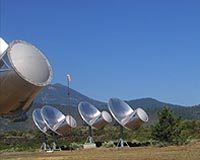| . |  |
. |
Dulles VA (SPX) May 21, 2009 Orbital Sciences has announced that its Minotaur I rocket successfully launched the Tactical Satellite-3 (TacSat-3) for the U.S. Air Force. The mission originated from the Mid-Atlantic Regional Spaceport (MARS) launch facility at NASA's Wallops Flight Facility on Wallops Island, VA. At approximately 7:55 p.m. (Eastern), the rocket's first stage ignited, beginning its flight into low-Earth orbit. Approximately 12 minutes later, the Minotaur I deployed the TacSat-3 spacecraft in its targeted orbit of approximately 285 miles (460 kilometers) above the Earth's surface. The mission was the 16th mission for the Minotaur program since its inception in 2000, all of which have been fully successful. It was also the third Minotaur I launch from the MARS facility, following the TacSat-2 and NFIRE missions conducted from the Eastern Virginia launch site in 2006 and 2007, respectively. Including the TacSat-3 mission, which carried four other smaller payloads, Minotaur I rockets have put a total of 30 satellites into orbit. "We are very pleased with the results of this evening's flight of the Minotaur I rocket, and are proud to be able to support the Air Force's important work in the area of Operationally Responsive Space (ORS) systems," said Mr. Ron Grabe, Orbital's Executive Vice President and General Manager of its Launch Systems Group. "Following this successful launch, our Minotaur launch team's focus will shift to the Minotaur IV vehicle, which will considerably extend the performance of the Minotaur family." Orbital will conduct the first two Minotaur IV flights later this year when it launches TacSat-4, the next in the Air Force's series of smaller-sized tactical satellites, from Kodiak, AK, and the Space Based Space Surveillance (SBSS) satellite from Vandenberg Air Force Base, CA. The TacSat-3 spacecraft is designed to meet the growing need of U.S. forces for flexible, affordable and responsive satellite systems. The program is a joint effort of the Air Force Research Laboratory's Space Vehicles Directorate, Army Space and Missile Defense Command, Air Force Space and Missile Systems Center's (SMC) Space Development and Test Wing, the Department of Defense's ORS office, and the Office of Naval Research. The overall launch service and management for the Minotaur I vehicle was provided by the Air Force SMC's Space Development and Test Wing at Kirtland Air Force Base, NM.
related report TacSat-3's 12-month mission is to demonstrate capability to conduct hyperspectral imaging that is responsive to the needs of U.S. warfighters. The ATK designed and built spacecraft bus meets the TacSat program's goals of being operationally responsive, low-cost and high performance. ATK hardware includes the onboard command and data handling system, solar arrays, primary structure and interfaces to the launch vehicle and payload. ATK's innovative hexapetal bus design enables rapid integration and modular packaging of both bus and payload components - an enabling capability for future Operationally Responsive Space (ORS) missions that must meet a seven-day call-up requirement. "ATK's Responsive Space Modular Bus was utilized for TacSat-3 in order to provide a highly-capable spacecraft that was versatile enough to support this specific mission, while flexible enough to support a broad range of future ORS missions," said Blake Larson, president, ATK Space Systems. "ATK completed the critical design review within four months of program start, integrated the bus structure within 11 months, and delivered the bus to the customer in just over 15 months." Other innovative features of the ATK spacecraft design include the adoption of Integrated Systems Engineering Team standard interfaces, that were developed in parallel by a joint government-industry team of engineers; an agile three-axis stabilization system to enable payload sensors to collect precision data on-orbit and downlink processed information in the same orbit pass; a robust power capability with modular power options that can be tailored for specific mission requirements; and a high-strength structure with adaptable interfaces to support a variety of sensor payloads. ATK also supplied the Orion 50XL and Orion 38 solid rocket motors for Orbital Sciences Corporation, which performed flawlessly as the Minotaur's third and fourth stages, respectively. The motors are manufactured at ATK's Magna, Utah, facility. ATK also provided the Minotaur's carbon fiber composite payload fairing assemblies to protect the TacSat-3 during launch. The fairings separated approximately 140 seconds into the flight. "ATK played an integral role in this launch, from the solid rocket motors of the launch to the launch vehicle fairing and finally the spacecraft bus," said Larson. The TacSat-3 spacecraft is a pioneer of the emerging ORS program. It was designed to meet the growing need of U.S. forces for flexible, affordable and responsive satellite systems. The TacSat-3 program is a joint effort of the Air Force Research Laboratory's Space Vehicles Directorate, Army Space and Missile Defense Command, Air Force Space and Missile Systems Center's Space Development and Test Wing, the Department of Defense's ORS office, and the Office of Naval Research. Share This Article With Planet Earth
Related Links Orbital Military Space News at SpaceWar.com
 AFSPC May Use Allen Telescope Array For Space Surveillance
AFSPC May Use Allen Telescope Array For Space SurveillancePeterson AFB CO (SPX) May 19, 2009 An important and high visibility mission of the United States Air Force Space Command (AFSPC) is Space Situational Awareness (SSA). Space Surveillance, a key component of SSA, involves using the Space Surveillance Network (SSN) of telescopes and radars to detect, track, identify and catalog all man-made objects orbiting the earth. Knowing where orbiting objects are located in space is key ... read more |
|
| The content herein, unless otherwise known to be public domain, are Copyright 1995-2009 - SpaceDaily. AFP and UPI Wire Stories are copyright Agence France-Presse and United Press International. ESA Portal Reports are copyright European Space Agency. All NASA sourced material is public domain. Additional copyrights may apply in whole or part to other bona fide parties. Advertising does not imply endorsement,agreement or approval of any opinions, statements or information provided by SpaceDaily on any Web page published or hosted by SpaceDaily. Privacy Statement |